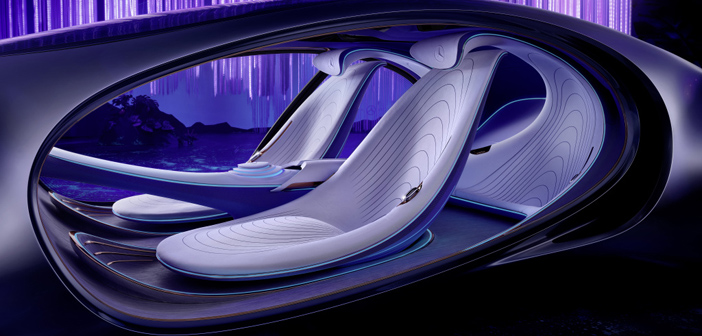The latest in Mercedes-Benz’s Vision series of concept cars was revealed at CES 2020. Its name, Vision AVTR, refers not only to a collaboration with the team behind the Avatar movies, but also to Advanced Vehicle Transformation. The autonomous concept vehicle majors on sustainability and embodies the vision of Mercedes-Benz designers, engineers and trend researchers for mobility in the distant future.
The electric, graphene battery-powered Vision AVTR is said to have been designed using a new, holistic approach that combines the interior, exterior and UX disciplines from the first sketch. The lateral opening of the outer line runs through the interior and creates a loop structure that is inspired by the connection between the Na’vi in the science fiction film Avatar and their natural environment on Pandora.
Nature serves as the main source of inspiration for the interior of the Vision AVTR. Flower-like and woven elements of the interior are designed to contrast with dynamic contours. Light strips in the seats are optically extended via projections on the center console.
The UX as a central element of the Vision AVTR is said to be comparable to a symbiotic organism. The idea is that as soon as the passengers board and take a seat, they merge with the vehicle and can feel and experience the world around them.
The vehicle has no visible buttons or switches. Instead, menus and functions are projected onto the body or hand of the driver or the passenger – a new level of human-machine fusion, according to Mercedes. The technology is only visible when the driver needs it and wants to use it. The dashboard design underlines this natural experience “with an atmospheric and luminous look”.
The front seat’s organic form is designed to be reminiscent of the leaf hammocks in Home Tree in the first Avatar film. The center console symbolizes the Tree of Souls, the most sacred place of the Na’vi. It extends to the A-pillar and creates its roof structure, which encloses the passengers in the rear seat like a cocoon.
The control unit is integrated into the central tunnel and encompasses both driver and passenger, and then continues into the rear seats. “A merging of human and machine happens”, according to Mercedes, by placing the hand on the center console: the interior comes to life and the vehicle recognizes the driver from his or her breathing. This is made visible on the instrument panel and the user’s hand.
The Vision AVTR’s seats feature vegan Dinamica leather. Dinamica – a recycled material made from old clothing, flags and PET plastic bottles – is said to be the first and only microfiber that guarantees environmental sustainability throughout the entire production cycle. This soft material also offers slip resistance for passengers on the seats.
Meanwhile the floor is decorated with an innovative wood called Karuun (“hidden treasure” in Indonesian). The raw material for Karuun is Indonesian rattan, which grows very quickly and is claimed to have significant advantages in cultivation over other types of wood or non-wood products. Rattan depends on biodiversity and cannot thrive in a monoculture. Therefore, the active support of its cultivation contributes to the protection of the planet’s rainforests and ensures a sustainable income for the local population.



